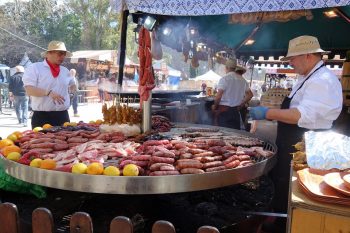The Argentinean Asado Explained Posted by Anais on Sep 30, 2019 in Spanish Vocabulary
Did you know that the land of mate, wine, tango, and soccer is also home to one of the best beefs in the world? Argentineans are very proud to have the highest quality meat and they really make the most out of it. You surely have heard of Argentinean barbeque before, but in this post I am sharing the main facts surrounding this mouthwatering culinary tradition.
Considered a type of barbecue belonging to Argentinean and Uruguayan cultures, the asado represents a deep-rooted tradition that happens every Sunday and is the perfect excuse for gathering with relatives, friends, and acquaintances, be it at home or in public places. It is for sure one of the most satisfactory culinary experiences a foodie (like myself) could ever have.
Heavenly Meats
An asado usually consists of the best meat cuts known in Argentinean cuisine: vacío (flank steak), matambre (fly shaker or elephant ear), tira de asado (ribs), bife de chorizo (rib eye), chinchulines (cow chitterlings), mollejas (sweetbreads), chorizo, and morcilla (black pudding). All of them must be perfectly grilled over brasas made either with carbón or with leña from different types of wood.
It is worth mentioning that other meats (e.g., pork, chicken, and lamb) may also end up being part of the banquet. Whatever the case, the best asado is accompanied by fritas (French fries), red wine or grilled provoleta (a variant of provolone cheese). It may also include bread, mixed salad or grilled vegetables.
The dressing for a typical asado is the renowned chimichurri, made of dried oregano, chopped parsley, onion, and garlic, seasoned with salt, black pepper, and paprika while soaked in olive oil. Another common aderezo is called salsa criolla, a sauce made of tomato and onion in vinegar.
The Asado’s Conductor
All of the crackle and preparing must be done under the guidance of one person — most commonly a man — who takes charge of the parrilla, earning the name of el asador.
The work of the asador is similar to that of a conductor in front of an orchestra, being responsible of the temperature, the quality of the embers, the seasoning of each cut, and the doneness of the meat.
Regarding that point, the most common done meats in an asado are vuelta y vuelta (literally ‘flip and flip’ or rare) and jugoso (‘juicy’ or medium rare), though there is no accounting for taste, so each fellow diner could ask for a different cooking: medio (‘medium’), cocido (medium well), and bien cocido (well done).
A successful asado must always be wrapped up with a toast honoring the one conducting the meal while shouting: “¡Un aplauso para el asador!” (A round of applause for the asador!)

Build vocabulary, practice pronunciation, and more with Transparent Language Online. Available anytime, anywhere, on any device.





